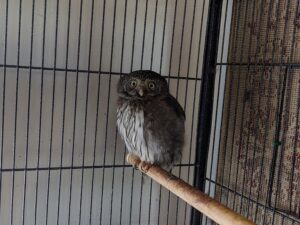Northern Pygmy Owl – Newton
 Name: Newton – Male
Name: Newton – Male
Species: Northern Pygmy-Owl
Liberty Arrival: October 2014/Adult
Injury/Condition: Partial amputation of right wing
Newton was transferred from a rehabilitation center in Montana at our request to become a remarkable addition to the education team. He had been brought to the Montana facility as an adult with a traumatic injury to his right wing, which required a partial amputation of that wing. His inability to fly classified him as non-releasable. Since his injury occurred when he was an adult, we do not know his exact age.
Northern Pygmy-Owl Facts
Description: Northern pygmy-owls are found in western North America from southeastern Alaska and British Columbia south through the western United States, and throughout most of Mexico. They do not migrate.
Life span: There is little reliable data on the life span of this species. The only known recapture of a banded northern pygmy-owl occurred in 2016 in Oregon. It was a male and at least 3 years, 11 months old when it was recaptured and rereleased.
Prey: Unlike nocturnal owls, it hunts primarily by sight during the day and dusk and not at night. Their preferred foods include birds, mice, and large insects with studies indicating that about 90% of their diet is comprised of small mammals and birds.
Babies/Nests: Northern pygmy-owls lay their eggs in cavities, lined with feathers, leaves, or other debris. They never create their own cavity but rely on cavities hollowed by woodpeckers or rot. The female will lay 2 to 7 eggs and incubates the eggs for 28 days. The young fledge 3 to 4 weeks later.
Búho Pigmeo del Norte – Newton
Nombre: Newton – Macho
Especie: Búho Pigmeo del Norte
Llegada a Liberty: Octubre 2014/Adulto
Herida/Condición: Amputación parcial de su ala derecha
Newton fue transferido de un centro de rehabilitación en Montana a Liberty por nuestra solicitud para que sea una adición notable a nuestro equipo educativo. Lo llevaron al centro de rehabilitación en Montana como un adulto con heridas traumáticas a su ala derecha. Su inhabilidad de poder volar lo clasifico como no poder ser liberado al estado salvaje. Como su herida ocurrió cuando era adulto, no sabemos su edad exacta.
Datos del Búho Pigmeo del Norte
Descripción: El búho pigmeo del norte se puede encontrar en el oeste de Norte América desde el sureste de Alaska y el sur de Columbia Británica a través del oeste de los Estados Unidos, y por la mayoría de México. Ellos no migran.
Duración de vida: Hay pocos datos confiables de la duración de vida de esta especie. La única recaptura del búho pigmeo de norte ocurrió en el 2016 en Oregon. Era un macho que tenia al menos 3 años con 11 meses cuando fue recapturado y re liberado a su estado salvaje.
Presa: No como los búhos nocturnos, cazan principalmente usando su vista durante el día y en el atardecer/anochecer, pero no en la noche. Su comida preferida incluye pájaros, ratones, y insectos grandes con estudios indicando que 90% de su dieta consiste de mamíferos y pájaros pequeños.
Nidos: El búho pigmeo del norte pone sus huevos en cavidades con plumas, hojas, o otros materiales similares. Nunca crean su propia cavidad si no dependen de las cavidades que crean pájaros como los pájaros carpinteros.
Crías: La hembra pone 2 a 7 huevos y los incuba por 28 días. Los jóvenes se van después de 3 o 4 semanas.


